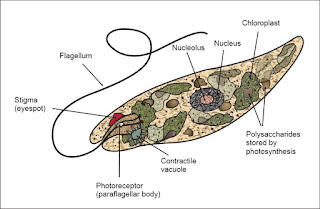General Characteristics and Classification of Porifera
General Characteristics
Classification
Phylum Porifera has been divided into three class which are-
Class1- Calcarea
Class2- Hexactinellida
Class3- Demospongea
CLASS 1: CALCAREA
• These are small sized calcareous sponges (10cm in height).
• Solitary or colonial.
• Body cylindrical or vase like in shape.
• Skeleton formed of calcareous spicules which may be one, three, or four rayed.
• All are marine animals.
• Body organisation may be asconoid, Syconoid or lenconoid type.
ORDER-1 HOMOCOELA
• Asconoid sponges with radially-symmetrical and cylindrical body.
• Body wall thin and unfolded; choanocytes line the spongocoel.
• Often colonial.
Example- Leucosolenia, Clathrina
ORDER-2 HETEROCOELA
• Syconoid and leuconoid sponges with thin walled vase shaped body.
• Choanocytes are found in radial canals or inflagellated chambers only.
Example-Schypha,Grantia
CLASS 2: HEXACTINELLIDA
• Generally hyalospongiae are found in medium sized sponges but some time few sponges
reached one meter in length.
• It is commonly known as glass sponges.
• Its body shape cylindrical, funnel shaped or cup shaped.
• The canal system was very typical and body organization Syconoid type.
• Hexactinellida class is found in deep marine water.
ORDER-1 HEXASTEROPHORA
• Spicules are star shaped (six-shaped) eg., hexasters
• Flagellated chambers regularly and radially arranged.
• Usually attached to substratum directly.
Example-Euplectella (Venus’s flower basket)
CLASS-3: DEMOSPONGIAE
• Solitary or colonial.
• Its body is cup or vase shaped.
• Demospongiae showed both small and large size.
• Spicules are seen monaxon or tetraxon
• The canal system is leuconoid type.
• All are marine porifera but except freshwater sponges (Spongillidae).
• The class Demospongiae is classified into the three sub classes.
SUBCLASS: 1 TETRACTINELLIDA
• Spicules siliceous and four rayed (tetraxon) or absent.
• Spongin fibres are absent.
• Mostly found in shallow water.
• Subclass Tetractinellida has been divided into three orders-
ORDER1- MYXOSPONGIDA
• Both spicules and spongin fibres are absent.
• Structure simple.
Example- Oscarella
ORDER2- CARNOSA
• Micro and are indistinct.
• All spicules are monaxons.
Example- Chondrilla and Plankia.
ORDER3- CHORISTIDA
• Micro. Tetraxon spicules with long axis.
Example-Thenea, Geodia
SUBCLASS:2 MONAXONIDA
• Spicules monaxon and siliceous type.
• Spongin fibres some time present or absent.
• Mostly monaxonida is occurring in shallow water.
• Some subclass lives in deep sea but some found in fresh water.
ORDER1- HADROMARINA
• Spongin fibres absent.
• Microscleres star shaped when present.
Example- Cliona (Boring sponge that bores in molluscan shell)
ORDER2- HALICHONDRINA
• Spongin fibres very little.
• Microsclers usually absent.
Example-Halichondria
ORDER3- POECILOSCLERINA
• Large spicules or megascleres of many types and united with spongin fibres and form
network.
• Microscleres C-shaped.
Example- Microciona
ORDER4-HAPLOSCLERINA
• Megascleres are only of one type having 2-rays only.
• Microscleres may be present or absent.
• Spongin fibres present.
Example- Spongilla and Chalina
SUBCLASS: 3 KERATOSA
• Generally spicules are absent in subclass Keratosa.
• The subclass Keratosa consists of horny sponges.
• Skeleton contains spongin fibres only.
Example- Horse sponge (Hippospongia) and Bath sponge
( Euspongia)







Comments
Post a Comment